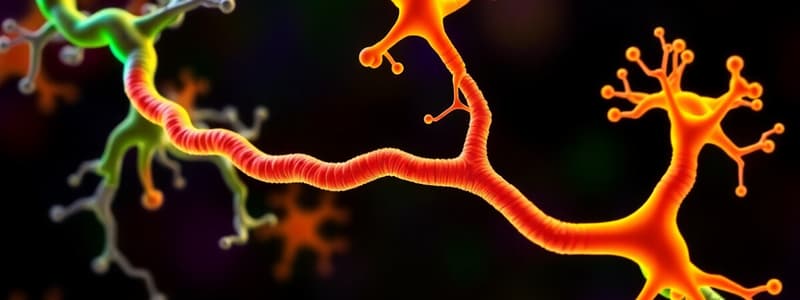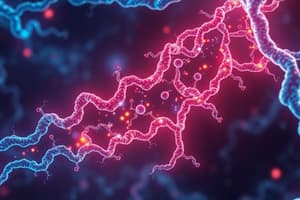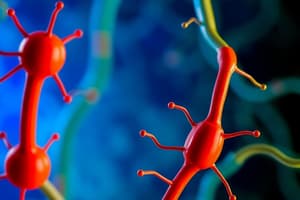Podcast
Questions and Answers
Ligand-gated ion channels contain receptor subunits surrounding a central pore.
Ligand-gated ion channels contain receptor subunits surrounding a central pore.
True (A)
Receptor tyrosine kinases are always typical examples, with the insulin receptor being a common one.
Receptor tyrosine kinases are always typical examples, with the insulin receptor being a common one.
False (B)
The regulation of ligand-gated ion channels involves a desensitized state with lower affinity for the agonist.
The regulation of ligand-gated ion channels involves a desensitized state with lower affinity for the agonist.
False (B)
Ligand-gated ion channels allow the flow of ions against a concentration gradient.
Ligand-gated ion channels allow the flow of ions against a concentration gradient.
Examples of ligand-gated ion channels include 5-HT3 and GABAA.
Examples of ligand-gated ion channels include 5-HT3 and GABAA.
The functioning of ligand-gated ion channels occurs on a timescale measured in seconds.
The functioning of ligand-gated ion channels occurs on a timescale measured in seconds.
Intracellular receptors are a type of ligand-gated ion channel.
Intracellular receptors are a type of ligand-gated ion channel.
Receptor tyrosine kinases are involved in 'receiving' and 'transmitting' signals.
Receptor tyrosine kinases are involved in 'receiving' and 'transmitting' signals.
The extracellular domain is responsible for capturing or binding signals.
The extracellular domain is responsible for capturing or binding signals.
Grb2 is a signaling molecule that directly triggers cell pathways.
Grb2 is a signaling molecule that directly triggers cell pathways.
Active Ras has no impact on protein activity and gene expression.
Active Ras has no impact on protein activity and gene expression.
Nuclear receptors can exist as homodimers in the cytoplasm.
Nuclear receptors can exist as homodimers in the cytoplasm.
The SH2 domain of Grb2 recognizes proline on signaling proteins.
The SH2 domain of Grb2 recognizes proline on signaling proteins.
Receptor:ligand stoichiometry varies greatly among tyrosine kinase-linked receptors (TKLRs).
Receptor:ligand stoichiometry varies greatly among tyrosine kinase-linked receptors (TKLRs).
Heterodimeric nuclear receptors do not join with any additional receptor.
Heterodimeric nuclear receptors do not join with any additional receptor.
Tyrosine phosphorylation patterns in the intracellular domain are irrelevant to signaling.
Tyrosine phosphorylation patterns in the intracellular domain are irrelevant to signaling.
Nuclear receptors can be either homodimers or heterodimers.
Nuclear receptors can be either homodimers or heterodimers.
All nuclear receptors bind DNA as trimers.
All nuclear receptors bind DNA as trimers.
Tyrosine-kinase linked receptors play a role in receptor signaling.
Tyrosine-kinase linked receptors play a role in receptor signaling.
Retinoic acid is an example of a ligand that binds to homodimeric nuclear receptors.
Retinoic acid is an example of a ligand that binds to homodimeric nuclear receptors.
All nuclear receptor subunits bind identical repeat sequences.
All nuclear receptor subunits bind identical repeat sequences.
Ligand-gated ion channels are a type of intracellular receptor.
Ligand-gated ion channels are a type of intracellular receptor.
The recognition of DNA by nuclear receptors is influenced by spacing and base pairs.
The recognition of DNA by nuclear receptors is influenced by spacing and base pairs.
Heterodimeric nuclear receptors cannot bind to RXR.
Heterodimeric nuclear receptors cannot bind to RXR.
Active Ras is involved in triggering numerous cell signalling pathways.
Active Ras is involved in triggering numerous cell signalling pathways.
Grb2 contains one 'arm' that binds to a phosphorylated tyrosine and another that does not interact with any signalling molecules.
Grb2 contains one 'arm' that binds to a phosphorylated tyrosine and another that does not interact with any signalling molecules.
Ligand-gated ion channels allow flow against a concentration gradient.
Ligand-gated ion channels allow flow against a concentration gradient.
Nuclear receptors that exist as homodimers are typically found in the nucleus.
Nuclear receptors that exist as homodimers are typically found in the nucleus.
Receptor tyrosine kinases typically exhibit a uniform structure across all examples.
Receptor tyrosine kinases typically exhibit a uniform structure across all examples.
The extracellular domain of a receptor is responsible for binding to ligands.
The extracellular domain of a receptor is responsible for binding to ligands.
The timescale for ligand-gated ion channels is measured in milliseconds.
The timescale for ligand-gated ion channels is measured in milliseconds.
The nuclear exclusion motif is exposed during receptor activation.
The nuclear exclusion motif is exposed during receptor activation.
Desensitization in ligand-gated ion channels usually results in decreased affinity for the agonist.
Desensitization in ligand-gated ion channels usually results in decreased affinity for the agonist.
Ligand:receptor stoichiometry remains constant across different types of receptors.
Ligand:receptor stoichiometry remains constant across different types of receptors.
Nuclear receptors always exist as trimers when binding to DNA.
Nuclear receptors always exist as trimers when binding to DNA.
The SH2 domain of Grb2 recognizes specific amino acids on signaling proteins.
The SH2 domain of Grb2 recognizes specific amino acids on signaling proteins.
All types of nuclear receptors have the same binding mechanism for DNA.
All types of nuclear receptors have the same binding mechanism for DNA.
Tyrosine phosphorylation patterns do not influence signal transduction.
Tyrosine phosphorylation patterns do not influence signal transduction.
Active Ras positively influences protein activity and gene expression.
Active Ras positively influences protein activity and gene expression.
5-HT3 and Nicotinic receptors are both examples of ligand-gated ion channels.
5-HT3 and Nicotinic receptors are both examples of ligand-gated ion channels.
Homodimeric nuclear receptors bind DNA as trimers.
Homodimeric nuclear receptors bind DNA as trimers.
Phosphorylation is required for the activation of nuclear receptors.
Phosphorylation is required for the activation of nuclear receptors.
Heterodimeric nuclear receptors are capable of binding to direct repeat half-sites.
Heterodimeric nuclear receptors are capable of binding to direct repeat half-sites.
The common example of homodimeric nuclear receptors includes retinoic acid.
The common example of homodimeric nuclear receptors includes retinoic acid.
All nuclear receptors require binding to a ligand to function.
All nuclear receptors require binding to a ligand to function.
Each subunit of a heterodimeric nuclear receptor binds two different half-sites.
Each subunit of a heterodimeric nuclear receptor binds two different half-sites.
Nuclear receptors do not directly involve in the signal transduction to the nucleus.
Nuclear receptors do not directly involve in the signal transduction to the nucleus.
The spacing of base pairs influences the recognition of DNA by nuclear receptors.
The spacing of base pairs influences the recognition of DNA by nuclear receptors.
Homodimeric nuclear receptors always bind to half-sites that are direct repeats.
Homodimeric nuclear receptors always bind to half-sites that are direct repeats.
Retinoid X receptor is a common example of a homodimeric nuclear receptor.
Retinoid X receptor is a common example of a homodimeric nuclear receptor.
Each subunit of a homodimeric nuclear receptor binds one repeat sequence.
Each subunit of a homodimeric nuclear receptor binds one repeat sequence.
Nuclear receptors that function as heterodimers are unable to bind a ligand.
Nuclear receptors that function as heterodimers are unable to bind a ligand.
The common example of half-sites for heterodimeric nuclear receptors is AGGACA(Nx)TGTCCT.
The common example of half-sites for heterodimeric nuclear receptors is AGGACA(Nx)TGTCCT.
All nuclear receptors are primarily located in the plasma membrane.
All nuclear receptors are primarily located in the plasma membrane.
Homodimeric nuclear receptors can impact gene transcription by binding to specific DNA sequences.
Homodimeric nuclear receptors can impact gene transcription by binding to specific DNA sequences.
Phosphorylation is not necessary for the activation of homodimeric nuclear receptors.
Phosphorylation is not necessary for the activation of homodimeric nuclear receptors.
Ligand-gated ion channels allow flow down a concentration gradient.
Ligand-gated ion channels allow flow down a concentration gradient.
Receptor tyrosine kinases are a uniform structure and do not vary between examples.
Receptor tyrosine kinases are a uniform structure and do not vary between examples.
The timescale for the actions of receptor tyrosine kinases is typically measured in minutes.
The timescale for the actions of receptor tyrosine kinases is typically measured in minutes.
Intracellular receptors are primarily located on the cell membrane.
Intracellular receptors are primarily located on the cell membrane.
Desensitization in ligand-gated ion channels results in higher affinity for the agonist.
Desensitization in ligand-gated ion channels results in higher affinity for the agonist.
Grb2 functions as a signaling molecule that directly triggers cell pathways.
Grb2 functions as a signaling molecule that directly triggers cell pathways.
The active form of Ras is known to inhibit various cellular signaling pathways.
The active form of Ras is known to inhibit various cellular signaling pathways.
Unlike ligand-gated ion channels, receptor tyrosine kinases lack a central pore structure.
Unlike ligand-gated ion channels, receptor tyrosine kinases lack a central pore structure.
Active Ras has a significant influence on cellular pathways and gene expression.
Active Ras has a significant influence on cellular pathways and gene expression.
SH2 domain of Grb2 recognizes phosphorylated tyrosine on an active receptor.
SH2 domain of Grb2 recognizes phosphorylated tyrosine on an active receptor.
Ligand-gated ion channels respond to stimuli on a timescale measured in hours.
Ligand-gated ion channels respond to stimuli on a timescale measured in hours.
Heterodimeric nuclear receptors exist solely in the cytoplasm.
Heterodimeric nuclear receptors exist solely in the cytoplasm.
The extracellular domain of receptor tyrosine kinases captures signals through a single transmembrane helix.
The extracellular domain of receptor tyrosine kinases captures signals through a single transmembrane helix.
All nuclear receptors exist only as homodimers.
All nuclear receptors exist only as homodimers.
Active nuclear exclusion motifs are prominently exposed during receptor activation.
Active nuclear exclusion motifs are prominently exposed during receptor activation.
RTKs rely on receptor:ligand stoichiometry that remains constant among all types.
RTKs rely on receptor:ligand stoichiometry that remains constant among all types.
Flashcards are hidden until you start studying
Study Notes
Receptor Types
- Ligand-gated Ion Channels (LGICs): These receptors are comprised of subunits surrounding a central pore. The receptor acts as the ion channel, allowing ion flow down a concentration gradient.
- Examples: 5-HT3, nicotinic, GABAA, AMPA/Kainate/NMDA, P2X
- Time Scale: milliseconds
- Regulation: The desensitized state usually has higher affinity for the agonist
- Biophysics: The physical characteristics of these channels are being further researched, with topics like the role of the lipid bilayer in ion channel function being explored.
Receptor Tyrosine Kinases (RTKs)
- Structure: RTKs have an extracellular domain for ligand binding, a single transmembrane helix, and an intracellular domain with tyrosine phosphorylation sites.
- Example: Insulin receptor
- Signal Transduction: Phosphorylated tyrosine residues on the intracellular domain bind adapter proteins, which in turn activate downstream signaling molecules, such as the Ras protein.
- Ras Signaling: Activated Ras triggers various cell signaling pathways, leading to changes in protein activity and gene expression, ultimately impacting cell proliferation.
Tyrosine Kinase-Linked Receptors (TKLRs)
- Structure: Similar to RTKs in that they have tyrosine kinase domains, with variations in structure and function.
- Signal Transduction: These receptors function by activating tyrosine kinases, initiating signaling pathways leading to changes in gene expression and cellular responses.
Nuclear Receptors
- Types:
- Homodimers: Consist of two identical subunits, found in the cytoplasm, and include receptors for estrogen, progesterone, androgen, glucocorticoids, and mineralocorticoids.
- Heterodimers: Composed of different subunits, usually an RXR (Retinoid X Receptor) and another receptor, found in the nucleus, and include receptors for thyroid hormone, retinoic acid, vitamin D, and 9-Cis retinoic acid.
- Mechanism:
- Homodimers: Bind to DNA as dimers, typically recognize inverted repeats (palindromes) with varying spacing between the half-sites.
- Heterodimers: Also bind DNA as dimers, typically recognize direct repeats with varying spacing between the half-sites.
- Activation: All nuclear receptors require phosphorylation for optimal activation.
Receptor Summary
- Ligand-gated ion channels: Rapidly activate ion flow upon ligand binding.
- GPCRs: Activate G proteins to initiate signaling cascades.
- Tyrosine-kinase linked receptors: Phosphorylation of tyrosine residues on intracellular domains initiates signaling cascades.
- Intracellular receptors: Ligand binding to these receptors inside the cell directly affects gene expression through DNA binding.
Ligand-Gated Ion Channels
- Ligand-gated ion channels are membrane-bound proteins that open in response to a specific ligand binding, enabling the passage of ions across the cell membrane.
- These channels play a crucial role in rapid signalling in the nervous system and muscle cells.
- They are composed of multiple receptor subunits that form a central pore allowing ions to flow down their concentration gradient.
- The receptor itself acts as the ion channel.
- Examples of ligand-gated ion channels include:
- 5-HT3 (serotonin receptor), nicotinic acetylcholine receptor, GABAA receptor, AMPA, Kainate, NMDA glutamate receptors, P2X purinergic receptor, muscarinic acetylcholine receptor, GABAB receptor, and mGluR glutamate receptors.
- Their signalling is rapid, occurring within milliseconds.
- They undergo desensitization, a process where continued exposure to the agonist reduces the channel's response. The desensitized state often has a higher affinity for the agonist.
Receptor Tyrosine Kinases (RTKs)
- RTKs are transmembrane receptors that play a vital role in cell growth, differentiation, and survival.
- They consist of an extracellular domain that binds to ligands, a single transmembrane helix, and an intracellular domain containing tyrosine kinase activity.
- Ligand binding to the extracellular domain triggers autophosphorylation of tyrosine residues within the intracellular domain.
- Phosphorylation creates docking sites for other signaling molecules, initiating a cascade of downstream events.
- The insulin receptor is a notable example of an RTK, although its structure is atypical.
- Another example is the epidermal growth factor receptor (EGFR), which is involved in cell proliferation and differentiation.
- Platelet-derived growth factor receptor (PDGFR) is also an important RTK involved in cell growth and wound healing.
- Growth receptor binding protein 2 (Grb2) is an adapter protein that links signaling molecules.
- Ras is a small GTPase protein that is activated by RTK signaling and plays a crucial role in cell proliferation.
Tyrosine Kinase-Linked Receptors (TKLRs)
- TKLRs share similarities with RTKs but have distinct mechanisms of action.
- They do not have intrinsic kinase activity.
- Instead, they associate with cytosolic tyrosine kinases upon ligand binding.
- These receptors exhibit significant variation in receptor:ligand stoichiometry.
- Examples of TKLRs include receptors for tumor necrosis factor-alpha (TNF-alpha), interleukin-1 (IL-1), transforming growth factor-beta (TGF-beta), and various cytokines.
Nuclear Receptors
- Nuclear receptors are intracellular proteins that regulate gene expression in response to lipid-soluble ligands.
- They are characterized by a DNA-binding domain and a ligand-binding domain.
- Nuclear receptors can be classified as:
- Homodimers: These receptors exist as dimers of identical subunits and are located in the cytoplasm. Examples include receptors for estrogen, progesterone, androgen, glucocorticoid, and mineralocorticoid.
- Heterodimers: These receptors form dimers with a retinoid X receptor (RXR). They are already present in the nucleus. Examples include receptors for thyroid hormone, retinoic acid (vitamin A).
- All nuclear receptors bind to DNA as dimers and require phosphorylation for activation.
- Homodimeric nuclear receptors typically bind to inverted repeat half-sites on DNA, which are palindromic sequences. The spacing between the half-sites determines the receptor's specificity.
- Heterodimeric nuclear receptors usually bind to direct repeat half-sites on DNA, and the spacing between these sites dictates their recognition.
Summary
- Ligand-gated ion channels, G-protein coupled receptors, tyrosine kinase-linked receptors and intracellular receptors each have distinct structure, function and signaling pathways.
- These receptors play crucial roles in cellular communication and diverse physiological processes.
Ligand-gated Ion Channels
- Ligand gated ion channels are comprised of receptor subunits encircling a central pore
- The receptor is also the ion channel
- Ion flow is dictated by concentration gradients
- Action occurs on a timescale of milliseconds
- examples include 5HT3, nicotinic, GABAA, AMPA, Kainate, NMDA, P2X
- The desensitized state tends to have a higher affinity for agonists
Receptor Tyrosine Kinases (RTK)
- The insulin receptor is atypical, often used as an example
- Examples of RTK receptors include epidermal growth factor receptor and platelet-derived growth factor receptor
- The extracellular domain binds to the signal ligand
- The single transmembrane helix connects the extracellular and intracellular domains
- The intracellular domain has tyrosine phosphorylation which determines the signal
- Adapter proteins are involved in signaling but do not themselves directly signal
Ras Cell Signaling
- Active Ras triggers the activation of numerous pathways
- Ras activation is essential for cell proliferation by inducing changes in protein activity and gene expression
Tyrosine Kinase-Linked Receptors
- Receptors are involved in many cellular processes, especially those involving cell differentiation and proliferation
- The stoichiometry of receptor:ligand is highly variable
- These receptors exhibit multiple variations on a theme, including different numbers of transmembrane domains
- These receptors regulate signal transduction pathways that can activate different downstream effectors and different biological functions
- Nuclear exclusion motif can be exposed or hidden to regulate nuclear localization
Nuclear Receptors
- These receptors are categorized as either homodimers or heterodimers
- Homodimeric nuclear receptors exist in the cytoplasm and include receptors for oestrogen, progesterone, androgen, glucocorticoid, and mineralocorticoid
- Heterodimeric nuclear receptors exist in the nucleus and include thyroid hormone, retinoic acid (vitamin A) receptors
- All nuclear receptors require phosphorylation for activation
- Homodimeric nuclear receptors exhibit inverted repeat half-sites as they bind to DNA
- Heterodimeric nuclear receptors bind to direct repeat half-sites
- The spacing of the recognition sites determines the structure and function of each receptor complex
- Heterodimer receptors have a common receptor monomer, RXR
Summary
- Ligand-gated ion channels, G-protein coupled receptors, tyrosine kinase-linked receptors, and intracellular receptors are all types of receptors that transduce signals in the body
Studying That Suits You
Use AI to generate personalized quizzes and flashcards to suit your learning preferences.




